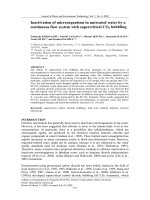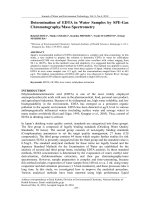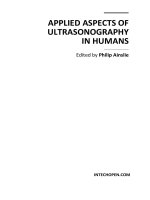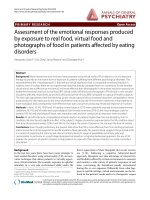trace analysis technology of nenophenyl in wastewater analysis by GCMS
Bạn đang xem bản rút gọn của tài liệu. Xem và tải ngay bản đầy đủ của tài liệu tại đây (575.7 KB, 11 trang )
Journal of Chromatography A, 988 (2003) 41–51
www.elsevier.com/locate/chroma
T race analysis of technical nonylphenol, bisphenol A and
17a-ethinylestradiol in wastewater using solid-phase microextraction
and gas chromatography–mass spectrometry
a, a a a a,b c
*
P. Braun , M. Moeder , St. Schrader , P. Popp , P. Kuschk , W. Engewald
a
Department of Analytical Chemistry
,
UFZ Centre for Environmental Research Leipzig-Halle
,
Permoserstrasse
15,
D-
04318
Leipzig
,
Germany
b
Department of Remediation Research
,
UFZ Centre for Environmental Research Leipzig-Halle
,
Permoserstrasse
15,
D-
04318
Leipzig
,
Germany
c
´
Institute of Analytical Chemistry
,
University of Leipzig
,
Linnestr
.3,
D-
04103
Leipzig
,
Germany
Received 19 July 2002; received in revised form 1 November 2002; accepted 9 December 2002
Abstract
To enable high sample throughput, an automated solid-phase microextraction (SPME) method coupled with GC–MS for
the trace analysis of technical nonylphenol, bisphenol A and 17a-ethinylestradiol was developed. The extraction
performance of different SPME fibre coatings was examined, with polyacrylate proving most suitable. Although study of the
extraction time showed that the analytes have not reached equilibrium after 3 h, as a compromise an extraction time of 1 h
21
was applied in all the experiments with detection limits between 0.04 and 1 mg l for wastewater effluent. The mean
reproducibility of the technique is 8% RSD. Carry-over effects are negligible. The linearity of calibration curves ranges over
three orders of magnitude. The method was tested for determining the analytes in influents and effluents of constructed
wetland plants and in model wastewater used in laboratory experiments.
2002 Elsevier Science B.V. All rights reserved.
Keywords
:
Endocrine disruptors; Solid-phase microextraction; Water analysis; Nonylphenol; Bisphenol A; 17a-Ethinyles-
tradiol
1 . Introduction ellogenin. Such reproductive abnormalities in various
wildlife species are caused by estrogenic active
In the early 1990s British scientists showed that substances (denominated as endocrine disruptors or
male rainbow trout produce the yolk precursor EDs). EDs include both naturally occurring hor-
protein vitellogenin when they are exposed to sew- mones and anthropogenic chemicals such as syn-
age effluents or contaminated surface waters [1]. thetic hormones and industrial products like alkyl-
Normally only female rainbow trouts produce vit- phenols.
The target analytes of our investigations were
technical nonylphenol (t-NP), bisphenol A (BPA)
*
Corresponding author. Tel.: 149-341-235-2657; fax: 149-
and 17a-ethinylestradiol (EE) (Fig. 1). Technical
341-235-2625.
E-mail address
:
(P. Braun). nonylphenol is a degradation product of nonylphenol
0021-9673/02/$ – see front matter 2002 Elsevier Science B.V. All rights reserved.
doi:10.1016/S0021-9673(02)02052-6
42 P
.
Braun et al
.
/ J
.
Chromatogr
.
A
988 (2003) 41–51
method was examined in terms of its practicability
for the determination of the three components in the
sewage influents and effluents of wetland plants.
In addition, the applicability of the SPME–GC–
MS method to model wastewater was examined with
a view to usage as a screening method for estimating
ED elimination behaviour in plant model systems
[18–20].
Fig. 1. Chemical structures of the target analytes.
2 . Experimental
polyethoxylates (NPEOs) which are used as non-
2 .1.
Chemicals and materials
ionic surfactants in detergents, paints, herbicides,
pesticides and plastics [2]. Bisphenol A is one of the Technical nonylphenol (Pestanal, purity grade$
most commonly produced industrial chemicals in the 94%) was obtained from Riedel de Haen (Seelze,
world and is a component of polycarbonate plastics Germany), bisphenol A (purity grade$97%) and
and epoxy resins, the uses of which include lining 17a-ethinylestradiol (purity grade$85%) were pur-
food cans [2,3]. The alkylphenoles mainly enter chased from Fluka (Zwijndrecht, Netherlands), and
municipal wastewater treatment plants via industrial sodium chloride and methanol (SupraSolv) from
effluents. Due to their polarity, persistence and water Merck (Darmstadt, Germany). 4n-nonylphenol (4n-
solubility alkylphenols can pass through wastewater NP) was obtained from Dr. Ehrenstorfer (Augsburg,
treatment plants and enter the aquatic environment Germany) and b-estradioldiacetate from ICN Bio-
[1,4]. 17a-ethinylestradiol is a synthetic estrogen medicals (Aurora, Ohio, USA). Additionally, 2-
which is used as contraceptive. It occurs mainly in bromo-2,3-dihydro-1H-indene-1-ol (short form:
2
domestic sewage. The ethinyl group in position 17 bromindanol) and deuterium labelled [ H ] bis-
14
inhibits the metabolism of EE and is thus detectable phenol A (BPA d14) were synthesized at the Uni-
in surface water [5]. versity of Leipzig (Germany) and used as internal
Reliable methods are required for the trace de- standards.
tection of chemicals with endocrine disrupting po- For method development pure water from the
tential. The snag about the analytical procedures Modulab Analytical purification system produced
currently used for the determination of EDs—liquid– by Christ (Stuttgart, Germany) was used.
liquid-extraction (LLE) [6–8] and solid-phase ex- All samples, real wastewater samples and stan-
traction (SPE) [5,9–11]—is that they are lengthy and dards, were extracted automatically with the Mul-
substance-consuming as LLE involves the high tipurpose Autosampler (MPS 2) from Gerstel
¨
consumption of organic solvents and additional (Muhlheim, Germany). All fibres studied for SPME
further clean up steps. And although SPE needs method development were supplied by Supelco
lower amounts of organic solvents, the manual (Bellefonte, PA, USA). Before first use each fibre
version, needed for concentrations of large sample was conditioned in the split/splitless injector of the
volumes, still takes 8 to 10 h. Furthermore, the target GC as described in the Supelco’s conditioning
analytes have to be derivatized if GC–MS is used for instructions followed by blank analysis to determine
analysis. Although some applications of SPME in the condition quality.
connection with on-line silylation and GC–MS have Crimp capped vials (10 ml) sealed with a PTFE-
been published [12,13], they appear unsuitable for lined silicon septum were obtained from Gerstel
¨
routine analysis. (Muhlheim, Germany). Stock standard solutions of
In this work the capability and suitability of technical nonylphenol and ethinylestradiol (1000 mg
21
solvent-free solid-phase microextraction [9,14–17] ml ) were prepared in methanol and bisphenol A
21
was investigated for the enrichment of EDs. The (1000 mg ml ) in isopropanol, respectively. Stan-
P
.
Braun et al
.
/ J
.
Chromatogr
.
A
988 (2003) 41–51
43
dard mixtures in methanol were prepared weekly. All spiked water samples containing 105, 210, 263 and
21
solutions were stored in the dark at 4 8C until use. 333 mg ml NaCl at pH 2 were enriched. In both
cases extraction was performed with an 85 mmPA
2 .2.
Sampling collection fibre for 30 min.
Furthermore the desorption time was varied be-
Influent wastewater samples from a pilot scale tween 2 and 4 min and the desorption temperatures
wetland plant in Langenreichenbach (Germany) were chosen were 280 8C and 310 8C.
collected over 24 h and effluent samples were taken In all the optimization experiments a concentration
21
once a day. The samples were collected in 1 l amber level of 4–5 mg l of each ED was used and the
glass bottles with glass plugs and cooled at 4 8C. extraction temperature was always about 30 8C.
Analyses were performed within 2 days after sam- The linearity of the method was determined using
pling. two methanolic standard solutions at concentration
21
Model wastewater composition in accordance with levels of 10–13 and 100–130 mg ml , respectively.
DIN 38412 T24 was stored at 4 8C in the dark and The stock mixtures were diluted into a series of 13
investigations were performed within 5 days after standard solutions for calibration. All calibration
production. points were arithmetic means of duplicate measure-
Stock solutions of the internal standards bromin- ments.
21
danol (10 mg ml ), 4n-nonylphenol and b-es- Precision was ensured by a 5-fold SPME pro-
21
tradioldiacetate (1000 mg ml each) in methanol cedure for spiked pure water samples.
2
and deuterium-labelled [ H ] bisphenol A (1000 mg
14
21
ml ) in isopropanol, respectively were diluted with
2 .4.
SPE procedure
methanol.
The detection limits of the analytes in the various
Solid-phase extraction (SPE) for the determination
water samples were determined and compared with
of EDs in wastewater samples was performed in
those obtained using SPE.
accordance with Stumpf et al. [5] with minor modi-
fications. Briefly, a 1 l water sample was filtered
2 .3.
SPME method development
¨
(glass fibre filter GF52 from Schleicher and Schull,
Dassel, Germany), acidified to pH 2 and spiked with
SPME method development includes selecting the
100 ml of internal standard (1,2,3,4-tetrachloro-
optimum fibre coating, i.e. choosing a coating ma-
naphthaline, BPA d14, 4n-NP and estradioldiacetate;
terial which provides high sensitivity and selectivity.
21
final concentration 0.1 mg l each). Glass cartridges
An 85 mm polyacrylate (PA), 100 mm polydi-
methylsiloxane (PDMS) and 65 mm polydi- were filled with 100 mg LiChrolut EN and 250 mg
methylsiloxane/divinylbenzene (PDMS/DVB) were LiChrolut RP-18 from Merck (Darmstadt, Ger-
examined as fibre types. A 9.5 ml amount of water many), conditioned with n-hexane and acetone as
21
containing 105 mg ml NaCl was acidified with 2% well as pure water of pH 2. After sample addition at
21
H SO to pH 2. Furthermore 19 ng bromindanol and a flow rate of 3 ml min , the cartridges were dried
24
an aliquot of methanolic ED-solution were added. for 90 min with inert gas (argon). The analytes were
Each fibre was completely immersed for 1 h in the eluted with 831 ml acetone and the extracts were
aqueous standard solution, which was agitated at 500 concentrated to about 200 ml by a gentle stream of
r.p.m. argon. The samples were cleaned up on a 1 g silica
Optimization of the extraction yields of the ana- gel column (deactivated with 1.5% water) precon-
lytes depending on time was performed in the range ditioned with an n-hexane/acetone mixture (65/35;
of 20–180 min. v/v). After loading the sample, the analytes were
The optimum pH and salt level were examined as eluted with 10 ml n-hexane/acetone (65/35; v/v).
parameters influencing the extraction efficiency. In For off-line derivatization the eluate was evaporated
this context 10 ml pure water was spiked with the to dryness. Then the analytes were silylated for 1 h
EDs and extracted at pH 2, 4 and 8. In addition at 60 8C with 100 ml Sylon BTZ (Supelco, Belle-
44 P
.
Braun et al
.
/ J
.
Chromatogr
.
A
988 (2003) 41–51
fonte, PA, USA). Excessive reagent was hydrolyzed for BPA d14, m/z 314/356 for estradioldiacetate and
with 200 ml pure water of pH 2 and the analytes m/z 266/264 for 1,2,3,4-tetrachloronaphthaline. The
were extracted with 500 ml n-hexane. Then the first-mentioned fragment ion was used for quantifica-
organic phase was concentrated to a final volume of tion.
200 ml, dried over sodium sulphate and transferred to
a 100 ml insert.
3 . Results and discussion
2 .5.
Instrumental parameters
3 .1.
Selection of the optimum SPME-fibre coating
A GC–MS system of Agilent Technologies (6890
´
GC with 5973 MSD, San Jose, USA) was used for The SPME coatings tested for the extraction
analysis. The capillary column was a fused-silica efficiency of the selected EDs differ in their polarity
HP-5 MS (30 m30.25 mm I.D., 0.25 mm film and sorptive properties. For example PA and PDMS/
´
thickness; Agilent Technologies, San Jose, USA). DVB are mostly used for the extraction of polar
The deactivated glass liner had an internal diameter compounds like phenols, whereas PDMS fibres are
of 2 mm. useful for the enrichment of more non-polar com-
The fibre was desorbed at 280 8C for 3 min in pounds [14,21]. Moreover while polyacrylate and
splitless mode. The penetration depth of the fibre polydimethylsiloxane belong to the absorptively
was about 5.4 cm. The GC oven temperature was as working coatings they show linearity over a wide
follows: 50 8C held for 4 min, 20 K/min to 140 8C, concentration range. Fibre coatings containing di-
maintained for 1 min, then heated at 10 K/min to vinylbenzene and carbowax, respectively, possess
280 8C and held for 8 min. Helium was used as adsorptive properties and hence linearity over a
carrier gas at a pressure of 55 kPa. smaller concentration range [22]. As the target
The transfer line was held at 280 8C and the ion analytes under study belong to a more polar class,
source at 250 8C. The MS worked in selected-ion- the maximum extraction yields would be expected to
monitoring (SIM) mode and the electron impact be obtainable using PA or PDMS/DVB [21]. Fig. 2
energy was set to 70 eV. shows the extraction yields obtained for each coating
The following ions were chosen: m/z 107/135 for material. Technical nonylphenol with the highest log
t-NP, m/z 213/228 for BPA, m/z 213/296 for EE, K of all the analytes in this study exhibits good
OW
whereas the first one mentioned was used for quanti- enrichment behaviour on each fibre type. Maximum
fication. For quantitation of t-NP the sum of areas of sensitivity was obtained on 100 mm PDMS. PDMS/
all isomers was chosen. For 4n-NP m/z 107/220, DVB seems best suited for the extraction of BPA.
BPA d14 m/z 222/239, b-estradioldiacetate m/z Unfortunately, blank analysis indicates partially high
314/356 and bromindanol m/z 133/115 were select- noise values for BPA, caused by BPA contained in
ed. For quantification ions at m/z 107, 222, 314 and the epoxy resin connecting the fibre needle to the
133 were used. fibre holder. Some fibre charges release high
Concerning the SPE procedure, about 1 ml sample amounts of BPA and avoid the detection of BPA in
21
was injected at 280 8C into the split/splitless-injector the lower mg l range. The ageing of fibres by
of the GC–MS system described above, the pulsed multiple use decreases the BPA noise, but this
splitless mode being selected. The temperature of the process is accompanied by lower extraction ef-
oven was initially set at 40 8C for 3 min. It was ficiency.
21
increased to 280 8C at a rate of 10 K min and held As shown in Fig. 2 all EDs can be extracted in
for 8 min. For quantitation (qualification) the corre- acceptable amounts with a PA fibre; this approach
sponding characteristic ions of the derivatives were was used in the following experiments. The lower
used: m/z 207 (221) for t-NP, m/z 357 (372) for extraction yield for the internal standard bromindanol
BPA and m/z 285 (300, 425, 440) for EE. The is tolerable, especially bearing in mind that real
following fragment ions were selected for the inter- wastewater samples are analyzed using 4n-NP, BPA
nal standards: m/z 179/292 for 4n-NP, m/z 366/383 d14 and b-estradioldiacetate as internal standards.
P
.
Braun et al
.
/ J
.
Chromatogr
.
A
988 (2003) 41–51
45
Fig. 2. Selection of the optimum fibre coating. Examined fibre types, 100 mm PDMS, 65 mm PDMS/DVB, 85 mm PA. 9.5 ml pure water
21 21 21 21
containing 2 mg l bromindanol (ISTBr), 4.08 mg l t-NP, 5.2 mg l BPA and 4.64 mg l EE, 1 g NaCl at pH 2; extraction time, 60 min;
extraction temperature, 30 8C; agitation speed, 500 r.p.m.; desorption temperature, 280 8C; desorption time, 3 min.
Nevertheless, during development work bromindanol 180 min. However, t-NP and BPA show good
was added to pure water samples in order to control response during the whole extraction time profile,
reproducibility during the extraction and the desorp- whereas the sensitivity for EE is lower. As a
tion step. Blank analysis of every fibre type in pure compromise an extraction time of 60 min was
water was performed and the chromatograms also applied in all the experiments for all the analytes. In
indicated noise values for t-NP. In the case of t-NP this case extraction was stopped before the analytes
contamination was probably caused by water prepa- had reached equilibrium. Compared to manual
ration. Experiments with only deionized, bidistilled SPME, the automated SPME procedure enables the
and commercially available water of HPLC grade strict observance of exact extraction times, enabling
indicated different amounts of t-NP. The lowest better reproducibility and a decrease in relative
contamination was found in multiple distilled water. standard deviation values.
The background concentration of BPA in PA-fibres
was estimated and found to be in the range of
3 .3.
pH and salt level
21
0.07–0.5 mg l . The blank level of t-NP in pure
21
water—approximately 0.1 mg l —complicates sam- The influence of pH on extraction efficiency was
ple quantitation by necessitating standard addition. studied at pH 2, 4 and 8. The higher the pH, the
lower the response and so a pH value of 2 was used
3 .2.
Extraction time in all the experiments.
The result of salt addition is shown in Fig. 4; for
The extraction time was investigated from 20 to t-NP the response decreases significantly as the salt
180 min. Fig. 3 shows the extraction yield depending concentration increases. BPA and EE show a slight
on time. The equilibrium time is reached when a increase in extraction yield at a NaCl concentration
21
further increase in the extraction time does not result of 105 mg ml , which is hardly lowered up to the
in a significant increase in the detector response. The saturated condition. The higher the salt concentra-
adjustment of equilibrium is a long-term process for tion, the higher the response of the internal standard
all analytes; no compound reaches equilibrium after bromindanol. To analyse the selected compounds,
46 P
.
Braun et al
.
/ J
.
Chromatogr
.
A
988 (2003) 41–51
Fig. 3. Extraction time profile for 85 mm PA fibre. Extraction conditions as in Fig. 2. s, bromindanol; h, t-NP; n,BPA;3, EE.
the addition of salt is not necessary. However, with was used as a compromise in the following experi-
regard to the multicomponent analysis of environ- ments.
mentally relevant compounds, in particular alkyl-
and chlorophenols [23] as well as pharmaceuticals
3 .4.
Optimization of desorption conditions
[9], where salt saturation leads to higher extraction
21
yields, a salt level of 105 mg ml sodium chloride Two different desorption temperatures (280 and
21
Fig. 4. Effect of salt addition, for 0, 105, 210, 263 and 333 mg ml sodium chloride, respectively, added to 10 ml pure water containing
21 21 21 21
5 mg l I.S. TBr, 4.08 mg l t-NP, 5.2 mg l BPA and 4.64 mg l EE. Extraction conditions: 85 mm PA fibre; extraction time, 30 min.
P
.
Braun et al
.
/ J
.
Chromatogr
.
A
988 (2003) 41–51
47
Table 1
Linear range, detection and quantitation limits as well as precision (LODs, LOQs for SPE–GC–MS method are listed in brackets)
21a 21b c
Compound Linear range Corr. Coef. LOD (mg l ) LOQ (mg l ) Precision
212 defg
studied (mgl ) (r ) pure model effluent (SPE) (% RSD)
pure model effluent (SPE)
t-NP 0.27–153 0.9919 0.2 0.4 0.8 (0.06) 0.6 1.2 2.4 (0.18) 6
BPA 0.34–195 0.9972 0.3 1 1 (0.02) 0.9 3 3 (0.06) 10
EE 0.03–174 0.9977 0.02 0.03 0.04 (0.01) 0.06 0.09 0.12 (0.03) 9
a
The limit of detection (LOD) corresponds to a signal-to-noise ratio of about 3:1.
b
The limit of quantitation (LOQ) is defined as three times the LOD.
c
n55.
d
Pure water.
e
Model wastewater composition in accordance to DIN 38412 T24.
f
Effluent of the pilot scale wetland plant of Langenreichenbach (Germany).
g
Limit of detection in effluent by use of SPE.
48 P
.
Braun et al
.
/ J
.
Chromatogr
.
A
988 (2003) 41–51
310 8C) within the recommended 85 mm fibre oper- water influent samples were examined at this internal
ating range were evaluated for a desorption time of standard level. Extraction was carried out using the
3 min. Due to the fairly high blind values of BPA conditions described in the experimental section.
illustrated in Section 3.1 which increased with the Compared with a pure water sample spiked at the
desorption temperature, 280 8C was chosen. same concentration level as the influent sample, the
Desorption time was studied at 2, 3 and 4 min. chromatogram (Fig. 5) indicates a decrease in sen-
The results showed that desorption was complete sitivity for each internal standard by a factor of 7 for
after 3 min at the selected concentration level. 4n-NP and 2 for BPA d14. There is no signal visible
In short, the optimum sampling of EDs from water for estradioldiacetate in the total-ion-chromatogram
works with an 85 mm PA fibre for 1 h in 9.5 ml (TIC) of the influent sample; only the extracted ion
21
water of pH 2 and 105 mg ml NaCl, agitated at a of m/z 314 shows a small signal for estradioldiacate,
fixed value of 500 r.p.m. and the analytes were which emphasizes a clear analyte-supressing effect.
desorbed at 280 8C for 3 min. With regard to the significant matrix influence on
the response, all the following measurements with
wastewater effluents and model wastewater samples
3 .5.
Linearity
,
precision and detection limits
were examined at a higher internal standard level.
To determine detection limits in defined effluent
The linearity of the SPME procedure was ex-
samples (constructed wetland in Langenreichenbach)
21
amined between 0.027 and 195 mg l . All analytes
and in model wastewater from laboratory reactor,
showed good linearity with correlation coefficients of
standard addition was used. The samples were
2
r $0.99 (Table 1).
multiply extracted: one sample only with internal
Precision was measured by a 5-fold SPME pro-
standard and the other ones with both internal
21
cedure at a concentration level of 4 mg l for each
standard and aliquots of an ED-standard mixture.
analyte. The RSD values were about 6% for t-NP,
The samples were compared with references (pure
10% for BPA and 9% for EE. Under the optimized
water) of the same concentration levels. Whereas
desorption conditions, carry-over of these samples
4n-NP and t-NP are suppressed 13- and 4-fold,
was negligible, 0% for t-NP and BPA and 2% for
respectively, for BPA, BPA d14 and EE no decrease
EE, and was completely prevented by keeping the
in response was observed. In Fig. 6 selected chro-
fibre in the PTV-injector (split mode) for 5 min.
matograms of effluent, model wastewater and a
The LODs determined in pure water and waste-
reference of spiked pure water are overlaid in order
water samples (effluent and model wastewater),
to show the matrix influence.
respectively, correspond to a signal-to-noise ratio of
Comparing the chromatograms of the model
about 3:1. The LODs of the EDs in pure water were
wastewater and the reference, no matrix influence is
appointed with blank values and lower calibration
observable for BPA, BPA d14 or EE. The sensitivity
levels used for the determination of the linear range
of t-NP and estradioldiacetate is reduced by a factor
21
and were found to range from 0.03 mg l for EE to
of 2 and for 4n-NP by 6. The LODs and LOQs of
21
0.4–1 mg l for BPA. The limit of quantitation
effluent and model wastewater are listed in Table 1.
(LOQ) defined as three times the LOD were also
Due to the high noise values for BPA, detection
calculated and listed in Table 1.
21
limits below 1 mg l are not achievable, i.e. the
relatively high detection limits of BPA are not caused
3 .6.
Analysis of water samples by the matrix (Section 3.1).
As Table 1 shows, the LODs of the EDs obtained
Prior to real sample analysis, pure water was using SPME are much higher than those of SPE
spiked with different amounts of 4n-NP, BPA d14 [5,10,11]. Concerning only LODs, SPME seems not
and estradioldiacetate in order to find the optimum to be the method of choice for trace analysis of the
internal standard concentration with finally 0.2 mg target analytes. However, the method’s performance
21 21 21
l 4n-NP, 0.4 mg l BPA d14 and 0.04 mg l characterized by high precision, reproducibility, good
estradioldiacetate being chosen. First of all, waste- linearity and last but not least fast, simple and
P
.
Braun et al
.
/ J
.
Chromatogr
.
A
988 (2003) 41–51
49
Fig. 5. The SPME–GC–MS-chromatogram with the narrow plotted line corresponds to an influent sample from the pilot-scale wetland plant
in Langenreichenbach spiked with internal standard only; as reference pure water spiked with 4n-NP, BPA d14 and estradioldiacetate at the
same concentration level was used (bold line).
Fig. 6. GC–MS-chromatogram of SPME-enriched analytes for an effluent from the pilot-scale wetland plant in Langenreichenbach, model
wastewater and pure water. All samples were spiked with internal standards and ED standard mixture at the same concentration level (0.8
21 21 21 21
mgl for 4n-NP and t-NP, 0.16 mgl for BPA d14 and 2 mgl for BPA, 0.16 mgl for estradioldiacetate and EE).
50 P
.
Braun et al
.
/ J
.
Chromatogr
.
A
988 (2003) 41–51
solvent free operation qualifies this method for an additional method for the fast, simple screening
21 21
analysis at the lower mg l level. and monitoring of the target analytes at the mgl
scale. The automation of the procedure combines
high sample throughput with high reliability, making
it useful for monitoring industrial processes and
4 . Conclusions laboratory experiments.
This work was mainly focused on the development
of a time- and substance-saving extraction technique
automatically coupled to GC–MS. It was in this
A cknowledgements
context that solvent-free SPME was examined. Poly-
acrylate was found to be the most effective coating
The authors would like to thank the BMBF
material in connection with the optimized extraction
(German Ministry of Education and Research) for
conditions comprising 1 g sodium chloride per 9.5
the financial support kindly provided (02WA9982/
ml water sample, pH 2 and an extraction time of 1 h
1).
at 30 8C using the fixed agitation speed of 500 r.p.m.
(Multipurpose Autosampler MPS 2).
The linearity of the method was found for over
three orders of magnitude. The optimized method
R eferences
showed good precision with RSD values between 6
and 10%. Carry-over was negligible. Detection limits
[1] K. Fent, Ecotoxicology, Thieme Verlag, Stuttgart, New York,
21
1998.
were in the lower mg l range. Thus the SPME–
¨
[2] M. Regitz, J. Falbe, Rompp Lexikon der Chemie, Thieme
GC–MS procedure can only be useful for determin-
Verlag, Stuttgart, New York, 1999.
ing a higher ED concentration with a minimum of
[3] The Bisphenol A Global Industry Group, Bisphenol A, 1 and
time, effort and avoidance of any solvent use. Matrix
2, Washington D.C., 1999 and 2000.
influence was found to be a sensitive parameter in
[4] R.E. Hester, R.M. Harrison, in: Endocrine Disrupting Chemi-
cals, Issues in Environmental Science and Technology, Vol.
method development. It is recommended that for
12, The Royal Society of Chemistry, Cambridge, 1999.
matrix changing a method adjustment is needed. In
[5] M. Stumpf, T.A. Ternes, K. Haberer, W. Baumann, Vom
the case of highly matrix loaded waters standard
Wasser 87 (1996) 251.
addition is preferred using an isotope-labelled inter-
[6] N. Theobald, C. Meyer, Forschungsbericht FKZ 29922281,
nal standard.
¨
Bundesamt fur Seeschifffahrt und Hydrographie, Hamburg,
2001.
Attention has to be paid to the sometimes fairly
[7] S. Cathum, H. Sabik, Chromatographia 53 (2001) 400.
high noise values of BPA and t-NP caused by SPME
[8] S. Cathum, H. Sabik, Chromatographia 53 (2001) 394.
fibre production which use materials contaminated
[9] M. Moeder, S. Schrader, M. Winkler, P. Popp, J. Chroma-
by BPA (epoxy resin) as well as t-NP. BPA sample
togr. A 873 (2000) 95.
data always has to be corrected by fibre blanks. The
¨¨
[10] R. Holtey-Weber, H. Farber, H.F. Scholer, Vom Wasser 92
blind value of t-NP is lower than BPA, but can
(1999) 1.
¨
[11] P. Spengler, W. Korner, J.W. Metzger,Vom Wasser 93 (1999)
hardly be avoided because of the ubiquity of this
141.
substance.
[12] M.I.H. Helaleh, S. Fujii, T. Korenaga, Talanta 54 (2001)
Although the SPE procedure is very time-consum-
1039.
ing and labour-intensive, it eliminates matrix com-
[13] Y. Takao, H.C. Lee, K. Arizono, Bunseki Kagaku 48 (1999)
pounds, features high enrichment capacity and al-
589.
21
[14] J. Pawliszyn, Solid Phase Microextraction—Theory and
lows detection limits in the ng l range. Hence SPE
Practice, Wiley–VCH, New York, Weinheim, 1997.
coupled to GC–MS analysis is the method of choice
[15] H. Kataoka, M. Ise, S. Narimatsu, J. Sep. Sci. 25 (2002) 77.
for the trace analysis of EDs in wastewater samples.
[16] J. Salafranca, R. Batlle, C. Nerin, J. Chromatogr. A 864
Alongside SPE, which has been established as the
(1999) 137.
standard protocol for determination of analyte traces
[17] Y. Takao, H.C. Lee, Y. Ishibashi, S. Kohra, N. Tominaga, K.
21
(# ng l ), SPME–GC–MS has been proved to be
Arizono, Jpn. J. Toxicol. Environ. Health 45 (1999) 39.
P
.
Braun et al
.
/ J
.
Chromatogr
.
A
988 (2003) 41–51
51
`´
[18] U. Kappelmeyer, A. Wiessner, P. Kuschk, M. Kaestner, [21] A. Peoalver, E. Pocurull, F. Borrull, R.M. Maree, Trends
Chemie Ingenieur Technik 73 (11) (2001) 1472. Anal. Chem. 18 (1999) 8.
[19] U. Kappelmeyer, A. Wiessner, P. Kuschk, M. Kaestner,
[22] J. Pawliszyn, Applications of Solid Phase Microextraction,
Chem. Eng. Technol., in press.
The Royal Society of Chemistry Chromatography Mono-
[20] U. Kappelmeyer, A. Wiessner, P. Kuschk, M. Kaestner;, in:
graphs, Cambridge, 1999.
A. Leeson (Ed.), Proceedings of the International In Situ and
[23] K.D. Buchholz, J. Pawliszyn, Anal. Chem. 66 (1994) 160.
On-Site Bioremediation Symposium, 6th, San Diego, CA,
United States, June 4–7, 2001, Vol. 5, Battelle Press,
Columbus, Ohio, 2001, p. 337.









